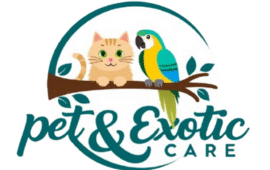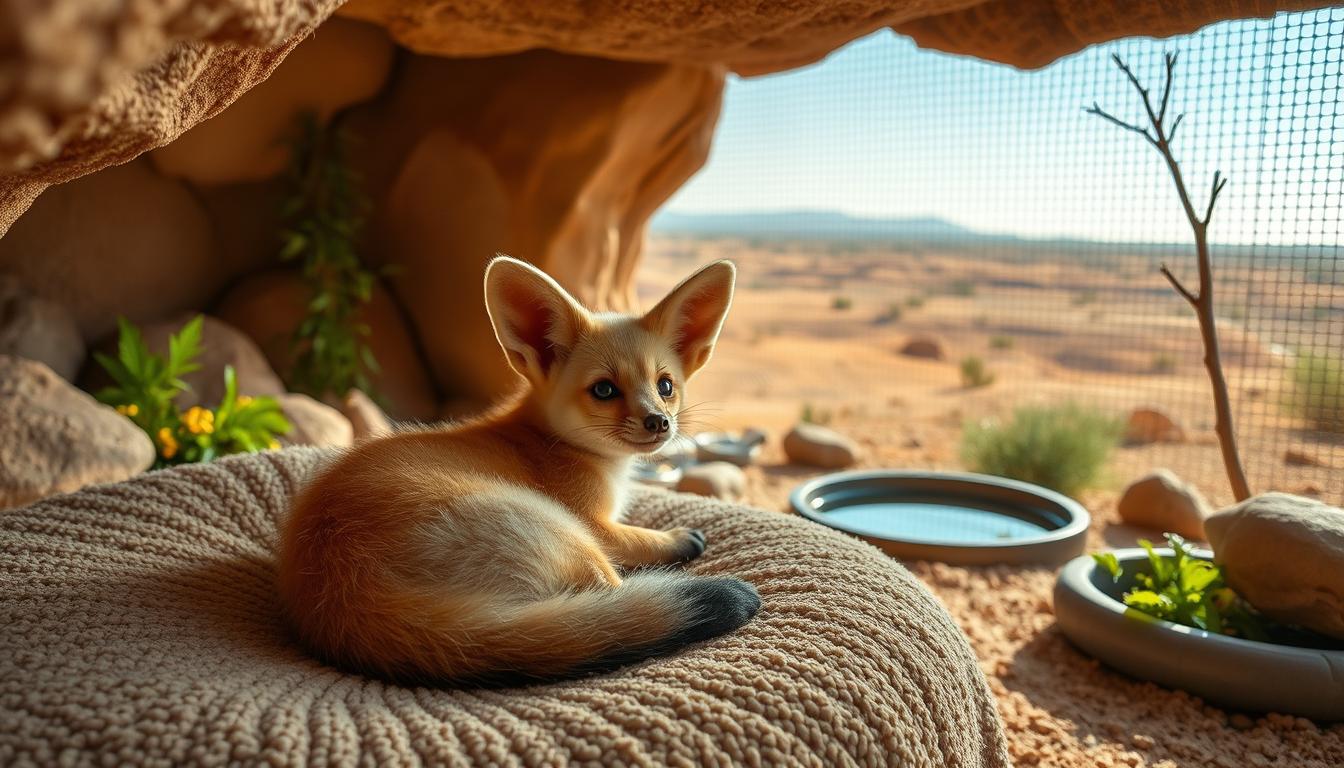Proper Fennec Fox Enclosure Size: Ensuring Your Pet’s Comfort
Keeping a fennec fox as a pet can be a unique and rewarding experience, but it comes with significant challenges. Native to the Sahara Desert, these small canids have specific needs that must be met to ensure their wellbeing. One of the most critical aspects of caring for a fennec fox is providing an adequate…
Keeping a fennec fox as a pet can be a unique and rewarding experience, but it comes with significant challenges. Native to the Sahara Desert, these small canids have specific needs that must be met to ensure their wellbeing.
One of the most critical aspects of caring for a fennec fox is providing an adequate enclosure that caters to their natural behaviors, such as digging and jumping. Despite their relatively small size, these foxes require substantial space to roam and exercise.
Understanding the unique care needs of these exotic animals is essential for any potential owner. This guide will explore the necessary conditions and features required to keep a fennec fox healthy and happy.
Key Takeaways
- Understanding the spatial needs of fennec foxes is crucial for their wellbeing.
- A proper enclosure is essential for accommodating their natural behaviors.
- Fennec foxes require specialized care and housing.
- Both indoor and outdoor housing options should be considered.
- Environmental conditions and enrichment features are vital for their health.
Understanding Fennec Foxes and Their Natural Habitat
To create a suitable environment for fennec foxes, it’s essential to understand their natural habitat and behaviors. Fennec foxes are native to the desert regions of North Africa, where they have adapted to survive in harsh conditions.
Physical Characteristics of Fennec Foxes
Fennec foxes are characterized by their oversized ears, which help dissipate heat and keep them cool in the scorching desert sand. Their thick fur and remarkable adaptability enable them to withstand extreme temperatures.
Desert Adaptations and Behaviors
In the wild, fennec foxes sleep in burrows during the day to avoid the heat. They are nocturnal, becoming most active during the cooler evening hours when they hunt and socialize. Their extensive burrowing behavior is a critical adaptation, creating complex tunnel systems up to 32 feet long with multiple entrances and exits for safety and temperature regulation.
Some key adaptations of fennec foxes include:
- Developing remarkable water conservation abilities, obtaining most of their hydration from their food and producing highly concentrated urine to minimize water loss.
- Having acute hearing that allows them to detect prey moving underground, a hunting adaptation that should be considered when designing enrichment activities in captivity.
- Living in family groups within burrow systems, with defined territories that they mark and defend.
Understanding these natural behaviors is essential for creating an enclosure that allows for expression of their instinctual activities like digging, exploring, and seeking shelter.
| Adaptation | Description | Benefit |
|---|---|---|
| Burrowing Behavior | Creating complex tunnel systems | Safety and temperature regulation |
| Water Conservation | Obtaining hydration from food and producing concentrated urine | Minimizing water loss |
| Acute Hearing | Detecting prey moving underground | Effective hunting in captivity |

Fennec Fox Enclosure Size Requirements
The enclosure size for fennec foxes is a critical factor in ensuring these animals lead healthy, stress-free lives. Fennec foxes are known for their energetic and curious nature, requiring ample space to move, dig, and climb.
Minimum Space Dimensions
When determining the minimum space dimensions for a fennec fox enclosure, it’s essential to consider their natural behaviors. Fennecs can dig up to 20 feet deep, indicating the need for deep substrate. A minimum enclosure size of 8 feet by 8 feet is recommended, but larger spaces are preferable.
Providing sufficient floor space allows fennec foxes to engage in natural behaviors such as pacing and foraging. The enclosure should be designed to accommodate their active lifestyle.
| Enclosure Dimension | Minimum Size | Recommended Size |
|---|---|---|
| Length | 8 feet | 10 feet |
| Width | 8 feet | 12 feet |
| Height | 6 feet | 8 feet |
Vertical Space Considerations
Vertical space is just as crucial as floor space for fennec foxes, given their impressive jumping and climbing abilities. A minimum height of 6 feet is recommended to accommodate their vertical movements.
- Incorporating multiple levels and platforms at varying heights encourages natural climbing behaviors and provides vantage points for observation.
- Secure ceiling mesh or wire is essential to prevent escape, as fennecs can jump surprisingly high.
- Climbing structures such as branches, ramps, and shelves maximize usable space and provide environmental enrichment.
By incorporating these elements, the enclosure can be made more engaging and stimulating for the fennec fox, promoting their physical and mental well-being.

Creating a Secure Containment System
Creating a secure containment system is crucial for keeping your fennec fox safe and preventing escape attempts. A well-designed cage is essential to ensure the well-being of your pet.
Preventing Digging Escapes
Fennec foxes are skilled diggers, and their enclosures should be designed to prevent escape attempts. A wired enclosure with a concrete or wood floor is a good option. The floor should be deep enough to prevent digging escapes.
Climbing-Proof Barriers
Foxes are excellent climbers and can jump high. To prevent climbing escapes, enclosure walls should be at least 6 feet tall with smooth surfaces. An inward-facing overhang of at least 45 degrees, extending 12-18 inches, can prevent fox from climbing out.
Choose materials like smooth acrylic panels, glass, or fine mesh wire for the walls. Eliminate potential “climbing aids” near the enclosure perimeter, and secure all doors and access points with multiple locking mechanisms.
Essential Environmental Conditions
To ensure the comfort and well-being of a fennec fox, its enclosure must mimic the desert environment it naturally inhabits. This involves controlling temperature, lighting, and humidity levels.
Temperature Requirements
Fennec foxes are adapted to the extreme temperatures of the desert. They need a temperature range that can accommodate cooler mornings and evenings, while also providing a warmer environment during the day. It’s crucial to avoid exposing them to extreme heat without adequate shade or cooling.
Lighting and Humidity Control
Proper lighting and humidity control are vital for creating a suitable environment.
- Fennec foxes are nocturnal, so a 12-hour day/night cycle with dimmer transition periods is recommended.
- Low humidity levels between 30-50% are ideal, with proper ventilation to prevent moisture buildup.
- UVB lighting is beneficial for indoor enclosures to support vitamin D synthesis.
Maintaining these conditions will help ensure the health and happiness of your fox.
Substrate and Flooring Options
Choosing the appropriate substrate and flooring is essential for the wellbeing of your fennec fox. A well-designed enclosure should mimic the natural habitat of these desert animals, providing comfort and stimulating their natural behaviors.
Sand and Digging Areas
Fennec foxes are known for their digging behavior, so incorporating sand or a similar substrate is crucial. A layer of sand will help your pet feel more at home, allowing them to exhibit their natural digging behavior. This not only provides exercise but also helps maintain their nail health.
Safe Flooring Materials
The base flooring of the enclosure should be escape-proof and durable. Concrete is a preferred option when properly sealed to prevent moisture absorption. Alternatively, wood flooring can be used if treated with non-toxic sealants and regularly inspected for damage.
| Flooring Material | Durability | Maintenance |
|---|---|---|
| Concrete | High | Low |
| Wood | Medium | High |
| Wire Mesh | High | Low |
It’s also important to incorporate varied flooring textures throughout the enclosure to provide sensory enrichment and natural foot conditioning. Transitional areas between different substrate types should be gradual to prevent injury.
Enrichment Features for a Stimulating Environment
Creating a stimulating environment for fennec foxes is crucial for their mental and physical well-being. These curious and playful animals require a variety of enrichment features to keep them engaged and active, giving them greater control over how they spend their time.
Tunnels and Hiding Spaces
Tunnels and hiding spaces are essential for providing foxes with a sense of security and stimulating their natural behaviors. These features allow them to hide, seek, and navigate through their enclosure, mimicking their natural habitat. Incorporating a variety of tunnels and hiding places made from safe materials can significantly enhance their environment.
Toys and Activity Centers
A lot of variety in toys and activity centers is necessary to keep fennec foxes engaged. This includes durable toys designed for exotic pets, food puzzle toys that challenge them and encourage foraging behaviors, and activity centers with multiple features like climbing platforms and digging areas. Regular rotation of these items is crucial to maintain their interest and prevent habituation.
Indoor vs. Outdoor Enclosure Considerations
For fennec fox owners, choosing between indoor and outdoor housing involves weighing the benefits and challenges of each option. The decision hinges on providing a safe, comfortable environment that meets the fox’s specific needs.
Benefits of Indoor Housing
Indoor enclosures offer better control over environmental conditions, ensuring the pet remains safe from extreme temperatures and predators. Indoor housing also facilitates easier monitoring and interaction, strengthening the bond between the fox and its owner.
Outdoor Enclosure Requirements
Outdoor enclosures require robust construction to prevent escape and predator intrusion. A wired enclosure with a concrete or wood floor is recommended, as fennecs can dig up to 20 feet deep and are excellent climbers. Outdoor housing also necessitates weather protection, including a fully insulated shelter area maintaining a minimum temperature of 68°F.
Outdoor enclosures must include multiple microenvironments, allowing the fennec fox to thermoregulate naturally. Regular inspections and proximity to the owner’s home are crucial for the owners to monitor their pet effectively.
Ensuring Your Fennec Fox’s Long-Term Comfort and Wellbeing
Ensuring the long-term comfort and wellbeing of your fennec fox requires careful planning and attention to detail. To keep your fennec fox healthy, it’s essential to provide regular veterinary care from an exotic animal specialist. This includes biannual check-ups to monitor their condition and address any emerging health issues promptly.
Maintaining a clean and secure enclosure is also crucial. Daily spot cleaning and weekly deep cleaning will help prevent disease and ensure your fennec fox remains healthy. Additionally, monitoring their behavior and maintaining detailed records of their weight, diet, and health history can help identify potential issues early on. By balancing security needs with enrichment opportunities, you can provide a stimulating environment for your fox and ensure a happy and healthy life for your pet.



